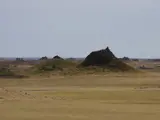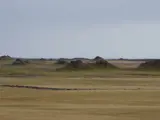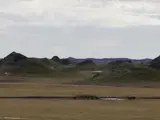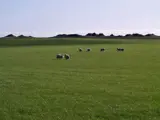The region gets its name from the fertile wetlands
Álftaversgígar
Álftaver is a vast protected region bordered by the rivers Kúðafljót to the east and Blautakvísl to the west. The region gets its name from the fertile wetlands that typify the area. Above and to the west of the settlement is a group of rootless cones (pseudocraters); Álftaver cone group, or namely "Álftaversgígar".
The cone group has protected the surrounding farms in a significant way from glacier outburst floods that occurr in the area due to geothermal or volcanic activity in the Katla volcanic system.
How do pseudocraters get formed ?
Pseudocraters, or "gervigígar" in Icelandic, are formed when lava flows over water-logged areas. That includes moorlands, mires, riverbeds and other similar areas. In short summary, the process is as follows:
- The lava flows over the watersoaked soil, but because of the difference in heat the surface water quickly evaporates in to steam, leaving the groundwater which the lava can't come in contact with.
- When the lava has covered the area it starts to thicken and pressure on the underlying soil increases. (pressure = thickness x density x gravitational acceleration)
- The increased pressure causes the water to be pressed out of the soil, coming into contact with the lava. The water superheats and forms steam that can't escape from under the lava, constantly increasing the pressure. Once the steam pressure exceeds the overlying burden of the lava, it pushes its way to the surface with great explosions and a pseudo-eruption has begun.
Looking at a crossection of a crater, you can see that the first emerging materials are usually rich in soil and other underlying materials. With increasing time you see more and more volcanic materials such as scoria and irregular lava rocks. During the summer of 2018, Hörður Davídsson from Efri-Vík has been building facilities to look at a cross section of a rootless cone in the vicinity of Hótel Laki near Kirkjubæjarklaustur, Along with the cross section, you will have the option of entering a bunker to have a look at the different layers deposited by various geological processes through the millenia. Katla UNESCO Global Geopark will proudly announce the completion of this interesting project when the time comes.
Rootless cones do not look different from other crater in any substantial way if the manage to erupt several times. If the eruptions are limited however, they usually form hillocks or rounded hills, commonly with a small lava nugget on top. The main difference of pseudocraters and regular craters is that the former hav no roots. That is to say, the have no deeper connection to a magma source as regular volcanic craters exhibit. Hence they are known as "Rootless cones".
A short video of the geosite Álftaversgígar. Video by Shiran De Silva, Published on Jun 18, 2018
Celebrating Earth Heritage
How to visit the Katla Geopark
Katla UNESCO Global Geopark is in central South Iceland



